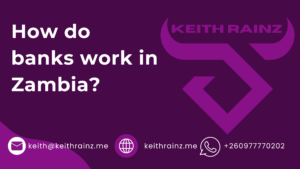Zambia’s interest rates are notably higher compared to many other countries, leading to increased costs for consumers when repaying credit. This situation raises questions about the underlying reasons and potential solutions. In this article, we will explore the key factors contributing to the high interest rates in Zambia and what can be done to address this issue.
Factors Contributing to High Interest Rates in Zambia
Inflationary Pressures
- Persistent Inflation: Zambia has faced periods of elevated inflation, influenced by fluctuating exchange rates, rising food and fuel prices, and supply chain disruptions. When inflation is high, the purchasing power of money declines, prompting lenders to raise interest rates to protect their returns.
- Uncertainty in Inflation: Unpredictable inflation can heighten risks for lenders, causing them to impose higher interest rates to offset potential losses from changing inflation levels.
Currency Instability
- Kwacha Depreciation: Zambia’s economy is heavily dependent on copper exports, making it vulnerable to global price fluctuations. A depreciating kwacha increases inflation and raises import costs, leading financial institutions to adjust their interest rates accordingly.
- Foreign Currency Scarcity: Limited access to foreign currency can exacerbate inflation and create uncertainty, prompting banks to charge more for loans as a safeguard against exchange rate fluctuations.
Increased Credit Risk
- Economic Challenges: Issues such as falling commodity prices, budget deficits, and concerns over debt sustainability contribute to a heightened perception of risk among lenders. This uncertainty can lead banks to raise interest rates to account for potential defaults.
- Underdeveloped Credit Infrastructure: Zambia’s evolving credit system can hinder accurate assessments of borrower creditworthiness. Insufficient data can result in higher interest rates as banks seek to mitigate risks.
Government Borrowing and Market Crowding
- Rising Public Debt: Increased government borrowing often competes with the private sector for available credit. This “crowding out” can lead to reduced credit availability for businesses and individuals, driving interest rates higher.
- Attractive Government Securities: Banks may favor investing in government bonds due to their relative safety and attractive returns, limiting the funds available for private lending and pushing interest rates up.
Monetary Policy of the Bank of Zambia
- Contractionary Monetary Policy: To combat inflation and stabilize the currency, the Bank of Zambia may implement a tight monetary policy, raising the policy interest rate. As central banks increase rates, commercial banks typically follow suit.
- Liquidity Management: By maintaining high reserve requirements, the central bank limits the funds available for lending, contributing to increased interest rates.
Limited Banking Competition
- Market Concentration: A few large banks dominate Zambia’s banking sector, reducing competitive pressure. With less competition, banks have less incentive to lower interest rates.
- High Operational Costs: The costs associated with providing banking services, especially in rural areas, can be significant, leading banks to pass these costs onto consumers through higher interest rates.
High Levels of Non-Performing Loans (NPLs)
- Defaults on Loans: Elevated levels of NPLs indicate that many borrowers fail to repay their loans, prompting banks to increase interest rates on new loans to recover potential losses.
- Risk Premiums: Banks often incorporate risk premiums into interest rates to account for the likelihood of future defaults.
Structural Economic Issues
- Commodity Dependence: Zambia’s reliance on copper makes it vulnerable to external economic shocks, such as fluctuations in commodity prices. A decline in these prices can destabilize the economy and raise lending risks.
- Limited Financial Inclusion: A significant portion of the population remains unbanked, increasing the costs for banks to serve existing customers and contributing to higher interest rates.
External Debt Challenges and IMF Programs
- Debt Servicing Pressure: Growing external debt strains Zambia’s financial resources. As the government prioritizes debt repayment, domestic resources for private sector borrowing become limited, resulting in higher costs for loans.
- IMF Conditions: In seeking IMF assistance for economic management, the country may implement measures like tightening fiscal policy and increasing interest rates to combat inflation, which can further elevate borrowing costs.
Conclusion
Zambia’s high interest rates stem from a complex interplay of economic factors, including inflation, currency volatility, credit risks, and structural challenges in the banking sector. Addressing these issues will require concerted efforts to manage inflation, enhance financial infrastructure, and improve public debt management. By tackling these underlying causes, Zambia could work towards reducing interest rates, making borrowing more accessible for businesses and individuals alike.

I am Keith Rainz a content creator in Zambia. I specialize in forex and crypto trading. You can WhatsApp me via +260977770202.







